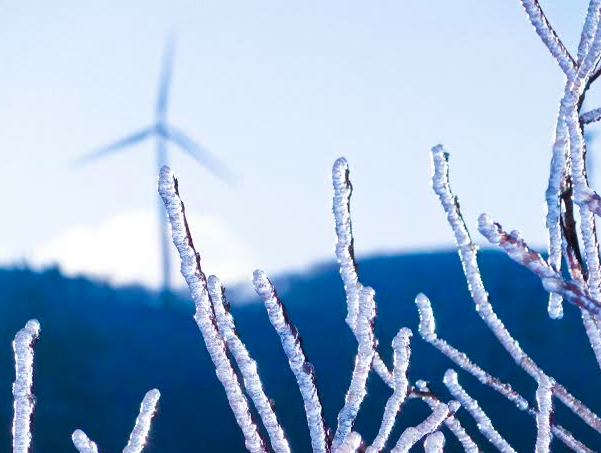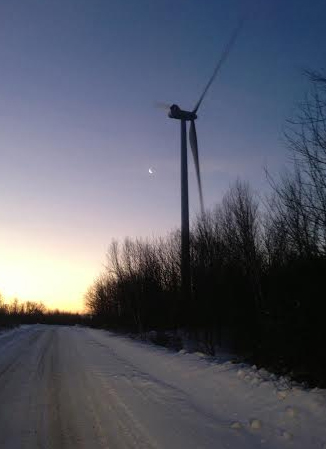Windpower technicians across the United States were forced to cancel maintenance runs in early January when the polar vortex – a mass of low-pressure and extremely cold air, usually found swirling above Siberia and Northern Canada – had moved south into American airspace. The air mass brought sub-zero temperatures to places unacquainted with extreme chill. This week, temperatures are dropping again.
For a wind-farm owner, the gusty winds of winter provide the year’s best energy production. But cold temperatures also wreak havoc on a turbine’s rotating parts. Oil and grease at temperatures near 0°F don’t flow well. When turbines ramp up in the cold, they experience more friction and loading than at more moderate temperatures.
In the middle of this seasonal give and take, windpower technicians keep the turbines turning. But chilly weather can be dangerous for technicians – just as dangerous as heat in the summer. Defining what temperature is too cold for work, however, is not as easy as simply picking a number, according to windpower companies.
“Our technicians have to make the call depending on the combination of temperature and wind,” says Chris Bley, CEO at Rope Partner, a wind turbine maintenance, repair, and inspection service. Also up for consideration is the task at hand. “It’s a tough decision, and often we spend a lot of time and money just to get out to the turbine and stand by.”
In Maine, recent freezing rain led to icy glazes on some blades’ leading edges. Elsewhere, they were coated with ice inches thick. Most wind companies forbid technicians from entering a work area when ice is present on a blade. Sometimes, workers are only made aware of ice when they hear the thumping sound of it falling to the ground.
On the job, Rope Partner technicians primarily dangle from ropes to access trouble spots on a turbine blade. To help make informed decisions about weather conditions, including ice, Rope Partner managers always pair experienced climbers with newer ones.
“One thing we can mitigate is the potential for falling, but the temperature and wind speed are out of our control,” says Bley. “Our technicians must make the decision on whether to make a repair in bad weather.”
In the High Plains, Broadwind Energy recently chose to keep its workers in warm offices. While the roads were in subpar shape – a problem solved by some blizzard-ready companies with track vehicles – cold-weather safety considerations led managers to wait for warmer days.
“A lot of attention is paid to the heat, but fatigue happens in the extreme cold, too,” says Jason Eddy, VP of Operations at Broadwind Energy. “The symptoms are just different.”
Click here to listen to a Wind Talk podcast with Jason Eddy, who discusses cold-weather safety.
Prolonged exposure to cold can lead to problems such as trench foot, frostbite, and hypothermia, according to OSHA. Danger signs include shivering, slurred speech, clumsy movements, fatigue, and confused behavior.
Andy Doak is the operations manager for First Wind at Bull Hill Wind Farm near Eastbrook, Maine. The farm has 19 Vestas V100, 1.8-MW machines in a region that typically experiences weather between 0°F and freezing throughout the winter.
“One of the things people often forget about in cold weather is that you still sweat,” Doak says. “When you stop working, that sweat is still taking heat off of your body. You get cold, and it can really jump on you if you’re not wearing clothing that sheds away moisture.”
In Maine, First Wind usually hires locals who are accustomed to the chill. They have a common sense approach to the cold, Doak says, which usually means donning extreme weather clothing – and layers of it.
When he goes on site during the winter months, Doak wears boots rated at -40° or below. They have a honeycomb insulation in the sole, which insulates the foot from the ground or, as is often the case with turbine technicians, a freezing-cold steel platform uptower. Steel can suck warmth from a pair of booths with little trouble, Doak says.
A thick base layer of long underwear is essential, he says, followed by an insulation layer covering the legs and torso. The outermost layer is complimented with cold-weather gloves and headware. Even with appropriate clothing, technicians are known to bring a space heater along with them for nacelle work.
While it’s important to be safe and wear the appropriate amount of clothing, companies acknowledge that taking precautions come with a notable cost: time.
“Duties take longer in the winter because of added layers of clothing,” Eddy says. “Also, technicians may need extra tethering for their devices because their gloves are thicker making drops more likely. Often, personal protective equipment will only allow so many layers. If arc-flash protection is required, the work may need a postponement until the weather allows it.
Overall, though, windpower companies recognize the need for safety.
“Companies know that putting someone out there is a risk,” says Rope Partner’s Chris Bley. “We’re just really conscious that we’re not going to put ourselves in any bad situations. The companies we work for know that, ultimately, it’s our decision whether to work.” WPE
Filed Under: News, Safety






